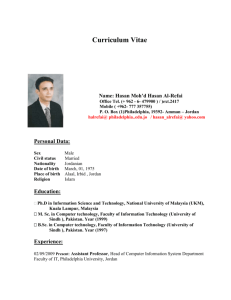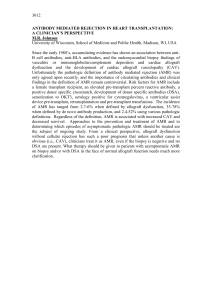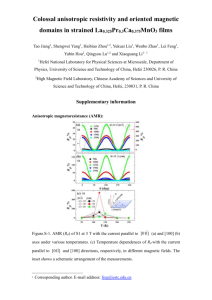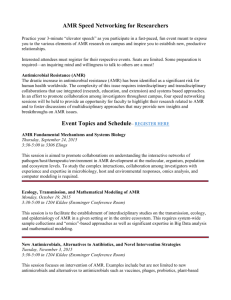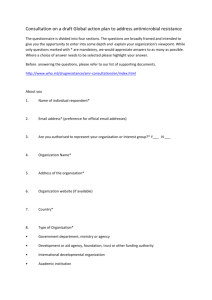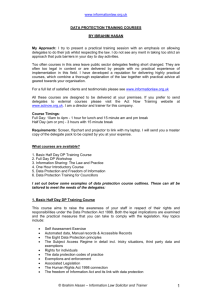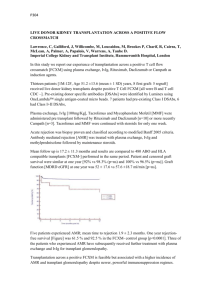Landry Guillain-Barre Syndrome ( LGBS)
advertisement
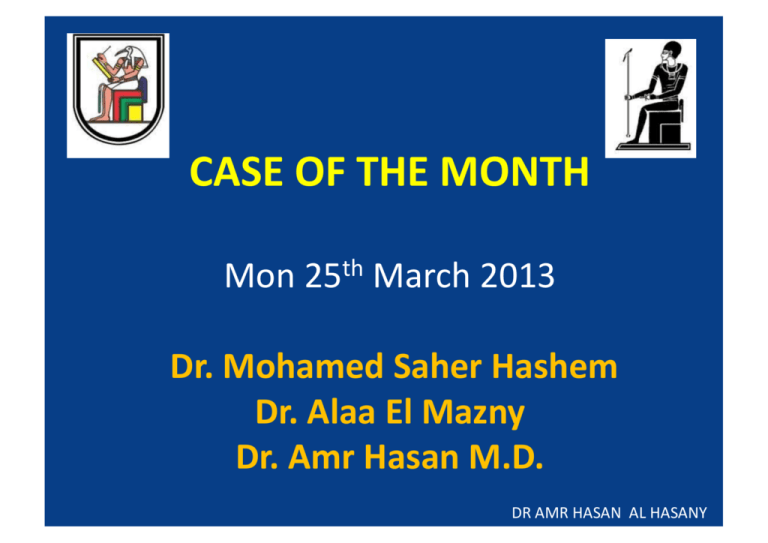
CASE OF THE MONTH Mon 25th March 2013 Dr. Mohamed Saher Hashem Dr. Alaa El Mazny Dr. Amr Hasan M.D. DR AMR HASAN AL HASANY Personal History • S.E., 19 years old female patient, from Benisuef , college student, married for 1 month , right handed , NSHMI. • Menstrual h/o : menarche at the age of 12 with regular cycles occurring every 28 days and lasts for 4 days. DR AMR HASAN AL HASANY Complaint Recurrent attacks of weakness of both U.L.s and L.L. s of 5 months duration. DR AMR HASAN AL HASANY Family History • No Similar Condition in her family. • -ve consanguinity. DR AMR HASAN AL HASANY Past History • -ve for Diabetes , Hypertension Previous surgical operations Drug allergy Chronic drug intake Blood Transfusion Other System Affection DR AMR HASAN AL HASANY Present History Oct 2012 Diarrhea : Watery Vomiting : 2-3 times / day not preceded by nausea abdominal pains and not related to meals , it occurred for 2 days. DR AMR HASAN AL HASANY Present History 1 week later: Weakness : Acute onset regressive course affecting both upper and lower limbs that occurred simultaneously over 2 days UL = LL , RT > LT and P=D. Patient felt her limbs flail. Patient became bedridden within 3 days. DR AMR HASAN AL HASANY Present History Tingling of upper and lower limbs suggesting of deep D>P , no symptoms sensory affection Urine Retention. Abnormal Involuntary Movement UL & LL during movement and increasing on reaching the target. Accumulation of food behind cheek and inability to close both eyes properly . DR AMR HASAN AL HASANY Examination I. General : 1) Vital Signs : Pulse 100 Temp 37.5 2) Chest Abdomen LN Joints BP 130/70 RR 25 Heart Skin NL II. Mental State : MMSE : 30/30 III. Speech : Normal DR AMR HASAN AL HASANY IV. Cranial Nerves : Bilateral LMN Facial Nystagmus in all directions of gaze and in the primary position V. Motor System .Tone : NL Power : G 3-4 UL = weakness E>F LL = weakness F>E .Reflexes -- AREFLXIA (UL – LL) -- Planter : BIL. EXTENSOR -- Abdominals : Preserved DR AMR HASAN AL HASANY VI. Coordination : +ve finger to nose +ve heel to knee VII. Sensory : Superficial Deep ( vibration & position) both intact DR AMR HASAN AL HASANY Localization !!! DR AMR HASAN AL HASANY UMNL Vs LMNL DR AMR HASAN AL HASANY UMNL Vs LMNL UMNL Nystagmus 5% oF LGB Bilateral extensor plantar 5% of LGB Distribution of weakness Retention of urine Ataxia May be Radicular distribution 5% of LGB May be sensory ataxia ( but nystagmus !!!) DR AMR HASAN AL HASANY UMNL Vs LMNL LMNL Flaccid weakness Shock stage Bilateral symmetrical LMN facial palsy Distal parasthesia !!!!!!! History of antecedent infection !!!!!!! Subjective !!!! DR AMR HASAN AL HASANY What is the most appropriate initial investigation for this Patient ? DR AMR HASAN AL HASANY MRI Brain DR AMR HASAN AL HASANY DR AMR HASAN AL HASANY MRI Brain DR AMR HASAN AL HASANY MRI Brain DR AMR HASAN AL HASANY EMG and NC study • No detectable abnormality DR AMR HASAN AL HASANY What is the most Probable diagnosis for this Patient ? DR AMR HASAN AL HASANY LGB WHAT ABOUT UMNL SIGNS DR AMR HASAN AL HASANY What is the most appropriate treatment for this Patient ? DR AMR HASAN AL HASANY • She received 6 sessions of plasma exchange -> nearly complete recovery of her symptoms , patient discharged ambulant with out support with physiotherapy after discharge complete recovery of her symptoms DR AMR HASAN AL HASANY Jan 2013 Vomiting : 2-3 times/day for 2 days not realted to meals. No diarrhea , abdominal pains or nausea. DR AMR HASAN AL HASANY Present History 3 days later: The Same attack exactly with the following differences 1- Reflexes are preserved in U.L. and brisk in L.L. 2- Bulbar palsy ( TRUE , TRANSIENT). 3- No sphincteric troubles. 4- Respiratory distress ( needed ICU admission) DR AMR HASAN AL HASANY Examination I. General : 1) Vital Signs 2) Chest LNS pulse 80 RR paradoxical BP 100/60 Temp 37.5 Abdomen Heart Joints Skin NL II. Mental : MMSE 30/30 III. Speech : Staccato DR AMR HASAN AL HASANY Examination IV. Cranial Nerves : Nystagmus in all directions of gaze with in the primary position NAD V. Motor System Tone = Nl Power= D>P LT > RT G 2-3 3-4 Reflexes : UL Grade 2 LL Grade 3 (knee and ankle) Plantar : BIL. EXTERNAL PLANTAR Abdominals : Lost DR AMR HASAN AL HASANY Examination VI. Coordination : +ve finger to nose +ve heel to knee RT LT : couldn’t be assessed VII. Sensory : Deep and Superficial DR AMR HASAN AL HASANY Localization !!! DR AMR HASAN AL HASANY UMNL Vs LMNL DR AMR HASAN AL HASANY UMNL Vs LMNL UMNL Nystagmus Bilateral extensor plantar Distribution of weakness Retention of urine Ataxia Brisk reflexes Respiratory distress LMNL Flaccid weakness Bilateral symmetrical LMN facial palsy Distal parasthesia History of antecedent infection Respiratory distress True bulbar DR AMR HASAN AL HASANY Should we revise the diagnosis? Is there any additional investigation to be done? DR AMR HASAN AL HASANY Due to her respiratory embarrasement >>>> PE was done. Patient Received 4 sessions of plasma exchange >>>> complete recovery of her symptoms. DR AMR HASAN AL HASANY Should we revise the diagnosis? Is there any additional investigation to be done? DR AMR HASAN AL HASANY Special Appreciation to Dr Alaa El Mazny DR AMR HASAN AL HASANY MRI Brain DR AMR HASAN AL HASANY DR AMR HASAN AL HASANY DR AMR HASAN AL HASANY DR AMR HASAN AL HASANY DR AMR HASAN AL HASANY DR AMR HASAN AL HASANY DR AMR HASAN AL HASANY MRI Cervical spine DR AMR HASAN AL HASANY DR AMR HASAN AL HASANY DR AMR HASAN AL HASANY MRI Brain DR AMR HASAN AL HASANY MRI Brain DR AMR HASAN AL HASANY Can we change diagnosis to M.S. ? DR AMR HASAN AL HASANY Dissemination in time Dissemination in space BETTER EXPLANATION ????? DR AMR HASAN AL HASANY The Patient back to normal !!!! DR AMR HASAN AL HASANY 7 days after marriage The 3RD attack DR AMR HASAN AL HASANY Feb 2013 Sensory : Acute onset regressive course of tingling and numbness affecting RT UL&LL’s 2 days later Weakness : RT UL& LL , LL>UL , D>P , patient felt her limbs flail with no muscle wasting nor twitches Patient was initially bed ridden for 2 days then she become Ambulant with MAX. support Cranial nerves Double vision on looking to left side. NO Sphincteric troubles DR AMR HASAN AL HASANY • In view of her MRI brain her traeating Neurologist prescribed her ACTH injection just before readmission , upon which she improved and her plegic U.L. Paretic and she became ambulant with max support instead of being bed ridden. • Then re admission for the third time. DR AMR HASAN AL HASANY Examination I.General 1) Vital Signs BP100/60 Pulse 80 2) Chest LNS II.Mental State : MMSE 30/30 III. Speech : Staccato RR 25 Temp 37 Abdomen Joints Heart Skin NL DR AMR HASAN AL HASANY III. Cr Nerves : 6th nerve palsy (left eye) No other abnormality detected IV.Motor : Tone & Status NL power = RT LT UL 3-4 5 LL D:2-3 5 P:3-4 Reflexes : UL : G 2 LL : G 3 Patellar and Adductor reflexes present. BIL. EXTENSOR PLANTAR Abdominals : Lost DR AMR HASAN AL HASANY Coordination : + ve finger to nose LT + ve heel to knee Rt couldn’t be assessed Sensory : Superficial and Deep intact DR AMR HASAN AL HASANY Patient was admitted afterwards receiving : 5 grams of Methyl Prednisolone marked improvement now she is completely symptom free DR AMR HASAN AL HASANY INVESTIGATIONS CBC Na , K Kidney Liver Urine analysis NL NL NL NL NL Glucose PT - PC - PTT- INR NL NL DR AMR HASAN AL HASANY • ESR : 1st Hour = 33 mm/hr 2nd Hour = 68 mm/hr (nl up to 20) (nl up to 20) • ANA : -ve • Lupus AntiCoagulant : NL (37.4) (34-40) • B2 Microglobulin : 959.1 ug/L (850-1150) DR AMR HASAN AL HASANY Neuro-physiological Studies : VEP : no detectable abnormalities bilaterally DR AMR HASAN AL HASANY Imaging DR AMR HASAN AL HASANY DR AMR HASAN AL HASANY DR AMR HASAN AL HASANY DR AMR HASAN AL HASANY DR AMR HASAN AL HASANY DR AMR HASAN AL HASANY DR AMR HASAN AL HASANY DR AMR HASAN AL HASANY DR AMR HASAN AL HASANY DR AMR HASAN AL HASANY DR AMR HASAN AL HASANY DR AMR HASAN AL HASANY DR AMR HASAN AL HASANY DR AMR HASAN AL HASANY CSF Examination • Ig G Index Ratio • OCB DR AMR HASAN AL HASANY CSF Examination • Ig G Index Ratio 3.1 (nl up to 0.7) • OCB POSITIVE DR AMR HASAN AL HASANY Should we establish diagnosis of M.S.? Is there any additional investigation to be done? DR AMR HASAN AL HASANY Better explanation ?? • CNS LYMPHOMA ? • SARCOIDOSIS ? • BEHCET DISEASE ? • CEREBRAL ANGIITIS ? DR AMR HASAN AL HASANY What is the most appropriate long term Treatment for this Patient ? DR AMR HASAN AL HASANY What is interesting in this case if diagnosis of M.S. is established • • • • LGB like presentation. Vomiting that precede the attacks. Initially normal MRI brain. Marvelous response to PE. DR AMR HASAN AL HASANY • ALAA SLIDES DR AMR HASAN AL HASANY Protocol for Management of Multiple Sclerosis (K.A.M.S. Protocol) Kasr Al Aini Multiple Sclerosis unit Multiple Sclerosis Research Group Neurology Department Faculty of Medicine Cairo University DR AMR HASAN AL HASANY K.A.M.S. Protocol Diagnosis of M.S. Treatment of M.S. Treatment of Relapsing Remitting MS Treatment of a relapse Treatment in between attacks (DMT) When to start DMT? How to choose DMT? How to follow up treatment response? When to switch to another line? Treatment of Secondary Progressive MS Treatment of Primary Progressive MS Treatment of Neuromyelitis optica (NMO) Treatment of Clinically Isolated Syndrome DR AMR HASAN AL HASANY K.A.M.S. Protocol Diagnosis of MS includes To prove it is M.S To exclude other diagnoses DR AMR HASAN AL HASANY K.A.M.S. Protocol To prove M.S. Clinical: •History and examination. •Evidence of CNS lesions dissemination in space and time. Paraclinical 1.Neuroimaging. 2.Evoked potentials. 3.CSF analysis What are the criteria used in diagnosis? criteria for the diagnosis of Relapsing remitting M.S. Mc Donald 2010 MRI criteria for dissemination in space (DIS) and time (DIT) 4 : DR AMR HASAN AL HASANY DR AMR HASAN AL HASANY K.A.M.S. Protocol To prove M.S. Clinical: •History and examination. •Evidence of CNS lesions dissemination in space and time. Paraclinical 1.Neuroimaging. 2.Evoked potentials. 3.CSF analysis What are the criteria used in diagnosis? criteria for the diagnosis of Relapsing remitting M.S. Mc Donald 2010 MRI criteria for dissemination in space (DIS) and time (DIT) 4 : DR AMR HASAN AL HASANY K.A.M.S. Protocol To exclude other diagnoses: A. Clinical Red Flags Optic neuritis: Absence of pain, retinal exudates or hemorrhages, severe disc swelling, bilateral involvement, no visual recovery after 1 month, uveitis. Brainstem syndrome: Hyperacute onset, vascular territory distribution (e.g. lateral medullary syndrome), age >50 years, isolated trigeminal neuralgia, fluctuating ocular/bulbar weakness, non-remitting symptoms, fever, meningismus, complete external ophthalmoplegia, third nerve palsy, focal dystonia or torticollis. Marked LMN signs: Areflexia, proximal weakness, bilateral LMN facial palsy, cauda equina lesion. Spinal cord syndrome: Hyperacute onset or insidiously progressive, complete transverse myelitis, sharp sensory level, Radicular pain, failure to remit, anterior spinal artery distribution (sparing posterior columns only), complete Brown-Sequard syndrome. Cerebral hemisphere: obtundation, confusion, cortical blindness, dementia, aphasia, extrapyramidal features, seizures. DR AMR HASAN AL HASANY K.A.M.S. Protocol To exclude other diagnoses: A. Clinical Red Flags Optic neuritis: Absence of pain, retinal exudates or hemorrhages, severe disc swelling, bilateral involvement, no visual recovery after 1 month, uveitis. Brainstem syndrome: Hyperacute onset, vascular territory distribution (e.g. lateral medullary syndrome), age >50 years, isolated trigeminal neuralgia, fluctuating ocular/bulbar weakness, non-remitting symptoms, fever, meningismus, complete external ophthalmoplegia, third nerve palsy, focal dystonia or torticollis. Marked LMN signs: Areflexia, proximal weakness, bilateral LMN facial palsy, cauda equina lesion. Spinal cord syndrome: Hyperacute onset or insidiously progressive, complete transverse myelitis, sharp sensory level, Radicular pain, failure to remit, anterior spinal artery distribution (sparing posterior columns only), complete Brown-Sequard syndrome. Cerebral hemisphere: obtundation, confusion, cortical blindness, dementia, aphasia, extrapyramidal features, seizures. DR AMR HASAN AL HASANY K.A.M.S. Protocol To exclude other diagnoses: B. Laboratory and radiological Red Flags CSF features atypical for MS at initial presentation: White blood cells > 50, protein > 80mg/dl, absence of oligoclonal bands (by isoelectric focusing technique). MRI features atypical for MS at initial presentation: Brain MRI: Normal, small lesions < 3 mm, subcortical location, prominent infratentorial involvement, prominent grey matter involvement (basal ganglia), symmetric confluent hemispheric white matter involvement, hydrocephalus, severe cerebellar/brain stem atrophy, no callosal/periventricular lesions, hemorrhagic lesions, cortical infarcts, meningeal enhancement, simultaneous enhancement of all lesions Spinal MRI: Large lesion spanning multiple segments (>2), severe swelling, full thickness lesions, leptomenengial enhancement, T1 hypointense lesions, diffuse abnormalities in the posterior columns DR AMR HASAN AL HASANY K.A.M.S. Protocol To exclude other diagnoses: C. Additional tests to be considered based on red flags CNS Inflammatory/Autoimmune Disease: ANA,CRP, Anti DS DNA,C3,C4, ANCA panel, Chest CT, eye exam, conjunctival biopsy, Pathergy skin test (Behcet's), Skin biopsy if suspicious rash present, CTA, angiogram . CNS Infection: Brucella antibodies, HIV test, HTLV1, and CSF antibodies (if isolated myelopathy with a lesion on spinal MRI), ESR, , small bowel biopsy for whipple . CNS Neoplasm/ Infiltrative Disorder: CSF cytology and flow cytometry, CXR, CT Chest\ Abdomen\Pelvis, Pelvic ultrasound, Mammogram, LDH, skeletal series, bone scan,DR Brain AMR biopsy. HASAN AL HASANY K.A.M.S. Protocol To exclude other diagnoses: C. Additional tests to be considered based on red flags CNS vasculopathy/Ischemic Disease: Notch3 mutations in CADASIL , MRA, CTA, standard angiogram, thrombophilia panel, Lupus anticoagulant . Nutritional deficiency/Toxicity: Vitamin B12, Copper and Zinc Levels, Ceruloplasmin, Folate, Heavy metal screen. DR AMR HASAN AL HASANY K.A.M.S. Protocol To exclude other diagnoses: C. Additional tests to be considered based on red flags Dysmyelinating/ Metabolic Disorders: Lumbar puncture, EMG/NCVs, biochemical studies, buccal or rectal mucosa biopsy for electron microscopy if neuronal ceroid lipofuscinosis (NCL) suspected, skin biopsy for fibroblast cultures (enzyme assays), or peripheral blood smear (vacuolated monocytes in NCL), Brain biopsy (rarely needed): fingerprint profiles, curvilinear and rectilinear bodies by E.M. in NCL oligodendrocytes; diffuse white matter gliosis by light microscopy in NCL. Urine/blood for biochemical studies, including levels of: WBC arylsulfatase A, Very long chain fatty, Fasting arterial lactate, Quantitative plasma amino acid and Urine organic acid analyses. DR AMR HASAN AL HASANY K.A.M.S. Protocol Treatment of Relapsing Remitting MS: Definition of a relapse. Treatment of a relapse. Treatment in between attacks (DMT). When to start DMT? How to choose DMT? How to follow up treatment response? When to switch to another line? DR AMR HASAN AL HASANY K.A.M.S. Protocol K.A.M.S. Protocol Team Prof.Dr. Sherif Hamdy Ass.Prof.Dr. Nirmeen Adel Dr. Marwa Farghaly Dr. Amr Hasan Dr. Mohammed Hegazy DR AMR HASAN AL HASANY Thank You DR AMR HASAN AL HASANY
